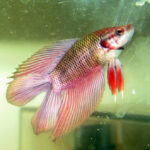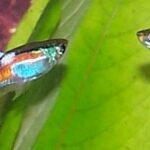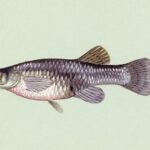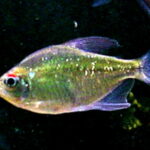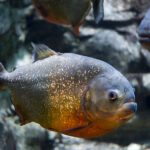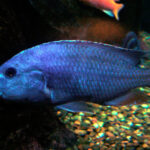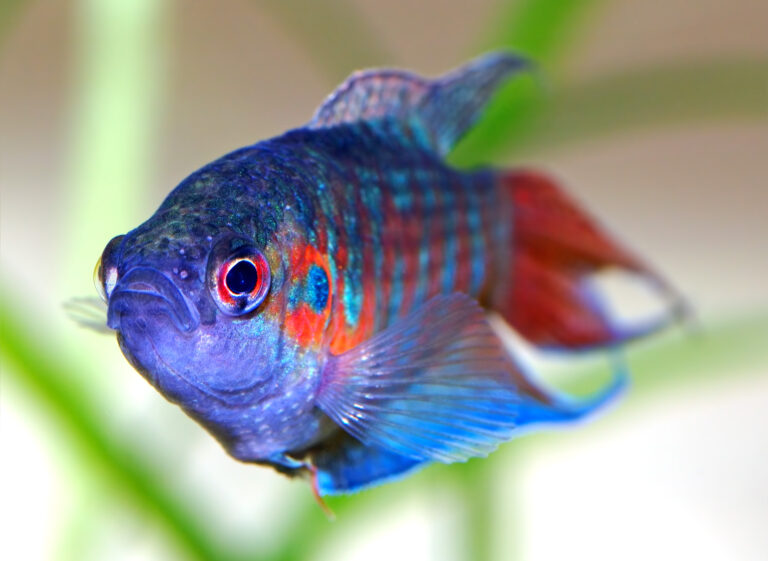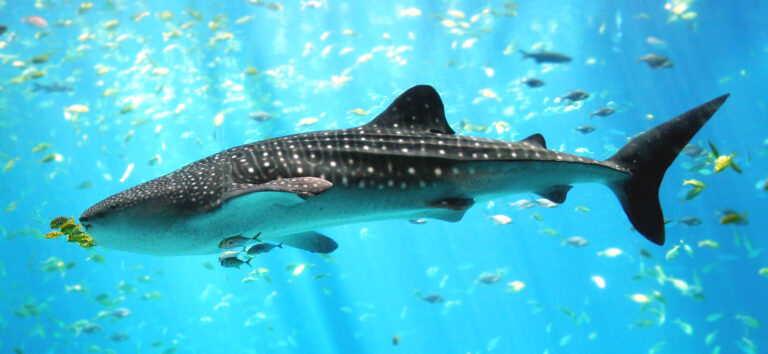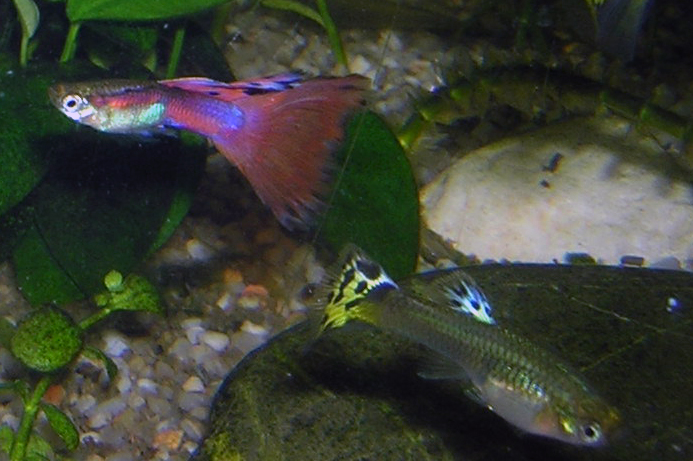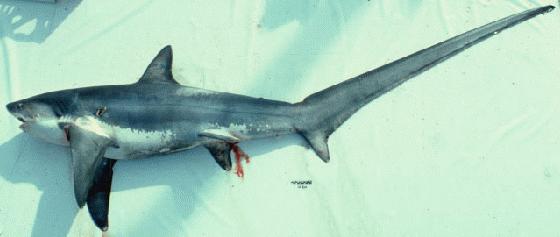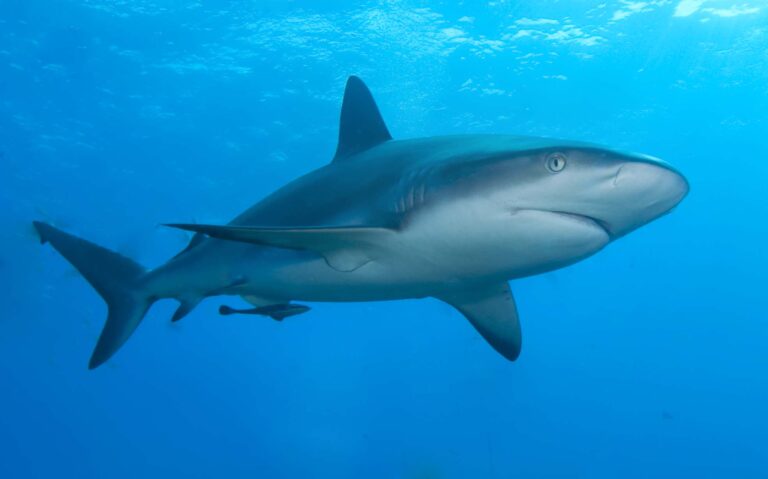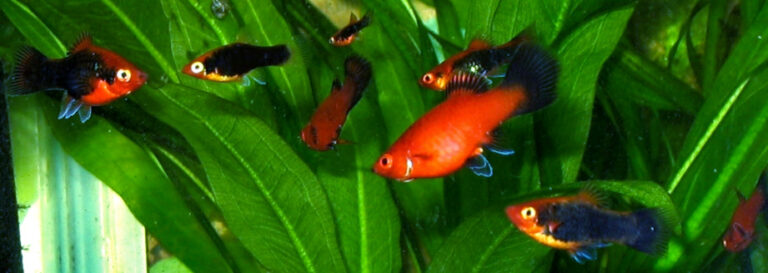Sunset Platy
By Ryan Maron | Last Modified: June 11, 2025

The Sunset Platy (Xiphophorus maculatus), commonly known as the Southern Platyfish, represents one of the most popular and recognizable freshwater aquarium species in the hobby today. This vibrant member of the Poeciliidae family has earned its place as a cornerstone species in both beginner and advanced aquarium setups due to its hardy nature, striking coloration, and peaceful temperament. Originally native to the freshwater systems of Central America and Mexico, the Sunset Platy has become globally distributed through the aquarium trade, where selective breeding has produced numerous color variations that showcase brilliant oranges, reds, and yellows reminiscent of a tropical sunset.
The ecological significance of Xiphophorus maculatus extends beyond its ornamental value, as this species serves as an important model organism in genetic research and plays a crucial role in its native freshwater ecosystems as both a consumer of small invertebrates and algae, and as a prey species for larger predatory fish. In aquarium environments, the Sunset Platy functions as an excellent community fish that helps maintain ecological balance through its omnivorous feeding habits and peaceful coexistence with other species.
| Feature | Details |
|---|---|
| Common Name | Sunset Platy |
| Scientific Name | Xiphophorus maculatus |
| Family | Poeciliidae |
| Typical Size | 4-6 cm (1.5-2.5 inches), 3-5 grams |
| Habitat | Slow-moving freshwater streams and ponds |
| Diet | Omnivorous – algae, small invertebrates, detritus |
| Distribution | Central America, Mexico, global aquarium trade |
| Conservation Status | Least Concern |
Taxonomy & Classification
The Sunset Platy belongs to the order Cyprinodontiformes, which encompasses a diverse array of small, predominantly freshwater fish species. Within the family Poeciliidae, Xiphophorus maculatus shares taxonomic relationships with other popular aquarium species including mollies, guppies, and swordtails. The genus Xiphophorus contains approximately 28 recognized species, with X. maculatus serving as one of the most extensively studied members due to its significance in genetic research and commercial breeding programs.
Systematic classification places the Sunset Platy within the following taxonomic hierarchy: Kingdom Animalia, Phylum Chordata, Class Actinopterygii, Order Cyprinodontiformes, Family Poeciliidae, Genus Xiphophorus, and Species maculatus. The species was first scientifically described by Günther in 1866, with the specific epithet “maculatus” referring to the spotted or mottled appearance characteristic of wild-type specimens.
The taxonomic position of X. maculatus within Poeciliidae reflects its evolutionary adaptations for live-bearing reproduction, a defining characteristic of this family. Molecular phylogenetic studies have revealed that the Sunset Platy shares a close evolutionary relationship with X. variatus (Variable Platy) and can readily hybridize with several related species, producing fertile offspring that have contributed to the extensive color variations seen in commercial breeding lines.
Physical Description
The Sunset Platy exhibits remarkable sexual dimorphism, with males typically reaching 3.5-4.5 centimeters in length while females grow larger at 4.5-6 centimeters. Males display a more streamlined body profile with a distinctive gonopodium, a modified anal fin used for internal fertilization, while females possess a broader, more robust body structure to accommodate developing embryos. The species’ most striking feature lies in its vibrant coloration, particularly in selectively bred varieties that showcase intense orange, red, and yellow hues across the body and fins.
The body shape of the Sunset Platy follows the typical laterally compressed profile common to Poeciliidae members, with a relatively deep body cavity that tapers toward a narrow caudal peduncle. The dorsal fin contains 10-12 soft rays, while the anal fin features 8-10 rays in females and transforms into the gonopodium structure in mature males. The caudal fin displays a rounded to slightly truncated shape, providing efficient propulsion for the species’ characteristic darting swimming behavior.
Coloration patterns in Sunset Platy varieties result from complex genetic interactions involving multiple pigment cell types, including melanophores, erythrophores, and xanthophores. Premium Sunset Platy specimens exhibit vibrant orange-red coloration across the anterior portion of the body, gradually transitioning to golden-yellow tones toward the posterior regions. The fins often display complementary coloration with enhanced intensity along the fin margins, creating the sunset-like appearance that gives this variety its common name.
Habitat & Distribution
The natural distribution of Xiphophorus maculatus encompasses the freshwater systems of eastern Mexico, Guatemala, and northern Honduras, where populations inhabit slow-moving rivers, streams, and coastal lagoons. These native habitats typically feature soft to moderately hard water with pH levels ranging from 7.0 to 8.5 and temperatures between 22-28°C (72-82°F). The species demonstrates remarkable adaptability to varying environmental conditions, thriving in both heavily vegetated areas and more open water environments with moderate current flow.
Wild Sunset Platy populations prefer shallow, well-oxygenated waters with abundant aquatic vegetation that provides shelter from predators and breeding sites. The species commonly inhabits areas with sandy or muddy substrates where organic detritus accumulates, supporting the diverse microfauna that constitutes a significant portion of their natural diet. Seasonal variations in water levels and temperature create dynamic environmental conditions that have shaped the species’ robust physiological adaptations.
Through the global aquarium trade, Sunset Platy populations have been introduced to numerous countries worldwide, with established populations reported in several regions including parts of the United States, Australia, and various tropical locations. These introduced populations typically establish in similar habitat types to their native range, demonstrating the species’ ecological flexibility and potential for successful colonization in suitable freshwater environments.
Diet & Feeding Behavior
The Sunset Platy exhibits omnivorous feeding behavior, consuming a diverse array of food sources that includes algae, small invertebrates, organic detritus, and plant matter. In natural habitats, the species demonstrates opportunistic feeding patterns, actively foraging throughout the water column and along substrate surfaces for available food resources. Their feeding strategy involves continuous grazing behavior punctuated by periods of more intensive feeding when food abundance is high.
Microscopic examination of gut contents from wild specimens reveals a diet composition consisting of approximately 40% plant material, 35% small invertebrates including copepods and chironomid larvae, 15% algae and diatoms, and 10% organic detritus. This dietary diversity reflects the species’ adaptability to varying food availability and seasonal fluctuations in prey populations. The relatively small mouth size limits prey selection to organisms typically measuring less than 2-3 millimeters in length.
Feeding behavior in Sunset Platy populations exhibits distinct patterns related to time of day, water temperature, and social dynamics within groups. Peak feeding activity occurs during dawn and dusk periods when many prey organisms become more active, while midday feeding rates typically decrease. Similar feeding behaviors can be observed among other popular aquarium species, including the diverse patterns seen in different platy fish varieties, which share comparable omnivorous feeding strategies and foraging behaviors.
Behavior & Adaptations
The Sunset Platy demonstrates highly social behavior, naturally forming loose aggregations of 10-30 individuals in wild populations. These groups exhibit dynamic social structures with temporary hierarchies based on size, age, and reproductive status. Males establish small territories during breeding periods but generally display peaceful interactions with conspecifics outside of mating contexts. The species shows remarkable behavioral flexibility, adapting quickly to changing environmental conditions and social compositions.
Swimming behavior in Sunset Platy populations involves frequent directional changes and vertical movements throughout the water column, a pattern that serves multiple functions including predator avoidance, foraging efficiency, and social communication. The species exhibits positive rheotaxis, showing preference for areas with gentle water movement that aids in respiration and provides access to drifting food particles. During periods of environmental stress, individuals may exhibit schooling behavior with tighter group cohesion.
Physiological adaptations enable the Sunset Platy to thrive in diverse freshwater environments, including enhanced osmoregulatory capabilities that allow survival in waters with varying salinity levels. The species demonstrates remarkable temperature tolerance, maintaining normal metabolic functions across a range of 18-30°C (64-86°F). Reproductive adaptations include the evolution of internal fertilization and live-bearing reproduction, providing significant survival advantages for offspring in dynamic aquatic environments.
Reproduction & Life Cycle
The Sunset Platy employs a sophisticated live-bearing reproductive strategy that distinguishes it from many other freshwater fish species. Sexual maturity occurs at approximately 3-4 months of age when individuals reach 2.5-3.0 centimeters in length. Males develop the specialized gonopodium structure, while females exhibit increased body depth and develop the distinctive gravid spot near the anal fin. Courtship behavior involves complex displays where males perform zigzag swimming patterns and display intensified coloration to attract females.
Gestation periods in Sunset Platy females typically range from 24-30 days, depending on water temperature and individual condition. Brood sizes vary considerably based on female size and age, with young females producing 10-20 fry while mature females may produce 40-80 offspring per reproductive cycle. The species demonstrates remarkable reproductive efficiency, with females capable of storing sperm for multiple reproductive cycles following a single mating event, enabling continued reproduction without additional male contact.
Newly born fry measure approximately 6-8 millimeters in length and possess fully developed fins and digestive systems, allowing immediate independent feeding and swimming. Juvenile development occurs rapidly under optimal conditions, with distinct coloration patterns appearing within 2-3 weeks after birth. Growth rates average 0.5-0.8 millimeters per week during the first three months, influenced by factors including water temperature, food availability, and population density. Sexual differentiation becomes apparent at 6-8 weeks of age when male gonopodium development initiates.
Predators & Threats
In their natural habitats, Sunset Platy populations face predation pressure from various fish species including larger characins, centrarchids, and cichlids that inhabit similar freshwater environments. Juvenile stages are particularly vulnerable to predation from aquatic insects, crustaceans, and small fish species that can consume newly born fry. The species has evolved several anti-predator adaptations including rapid acceleration capabilities, schooling behavior during threat detection, and preference for heavily vegetated areas that provide refuge opportunities.
Adult Sunset Platy populations demonstrate sophisticated predator avoidance behaviors, including enhanced vigilance during feeding activities and coordinated escape responses when threats are detected. The species’ reproductive strategy of live-bearing provides significant survival advantages over egg-laying species, as developed fry possess better escape capabilities and reduced vulnerability during early life stages. Environmental factors such as turbidity and vegetation density significantly influence predation success rates.
Anthropogenic threats to wild Sunset Platy populations include habitat degradation through agricultural runoff, urban development, and water extraction for human use. Water quality deterioration from chemical pollutants and nutrient loading poses increasing challenges for natural populations. Climate change impacts, including altered precipitation patterns and temperature fluctuations, may affect breeding success and habitat suitability in some regions. The species’ hardy nature and broad environmental tolerance provide some resilience against these emerging threats.
Conservation Status
The International Union for Conservation of Nature (IUCN) currently classifies Xiphophorus maculatus under the “Least Concern” category, reflecting the species’ stable population status and wide distribution throughout its native range. Wild populations remain abundant in most areas of their natural distribution, with no immediate conservation concerns identified for the species as a whole. The robust nature of Sunset Platy populations and their adaptability to diverse environmental conditions contribute to their favorable conservation status.
However, localized population declines have been documented in some regions where habitat modification and water quality degradation have occurred. Conservation efforts focus primarily on watershed protection and maintaining water quality standards in areas supporting native populations. The species’ importance as a model organism in genetic research has led to the establishment of captive breeding programs that maintain genetic diversity and provide insurance populations against potential future threats.
The extensive global distribution of Sunset Platy through the aquarium trade, while raising concerns about potential ecological impacts in introduced regions, also provides a form of species conservation insurance. Millions of individuals are maintained in aquarium systems worldwide, ensuring species survival even if wild populations face localized threats. Research institutions maintain specialized breeding lines that preserve genetic diversity for continued scientific studies and potential reintroduction programs if needed.
Human Interaction
The relationship between humans and Sunset Platy spans over a century of aquarium keeping, scientific research, and commercial breeding activities. The species ranks among the most popular freshwater aquarium fish globally, with millions of individuals bred and sold annually through pet trade networks. Commercial breeding operations have developed numerous color varieties and fin types, creating economic value estimated in tens of millions of dollars annually within the ornamental fish industry.
Scientific research utilizing Xiphophorus maculatus has contributed significantly to our understanding of genetics, developmental biology, and cancer research. The species serves as a model organism for studying genetic inheritance patterns, pigmentation mechanisms, and tumor development. Research facilities worldwide maintain specialized breeding colonies for ongoing studies, with findings applicable to both fish biology and human medical research. The species’ short generation time and ease of breeding make it particularly valuable for genetic studies.
Educational applications of Sunset Platy in classroom settings and public aquariums help promote understanding of aquatic ecosystems and fish biology among students and the general public. The species’ peaceful nature, attractive appearance, and relatively simple care requirements make it an excellent choice for introducing people to responsible aquarium keeping. Many aquarium enthusiasts begin their hobby with Sunset Platy populations, developing appreciation for aquatic life that often extends to broader conservation awareness.
Interesting Facts
The Sunset Platy possesses several remarkable biological characteristics that distinguish it from other freshwater fish species. One of the most fascinating aspects involves their ability to change sex under specific environmental conditions, a phenomenon known as sequential hermaphroditism. While rare, documented cases exist of female Sunset Platy developing male characteristics, including gonopodium formation, when maintained in all-female populations for extended periods.
Genetic studies have revealed that Sunset Platy possess an unusual chromosome system where sex determination involves multiple genetic factors rather than simple XY or ZW mechanisms. This complex genetic architecture contributes to the extraordinary color variations possible through selective breeding and explains why certain color combinations produce unexpected offspring patterns. The species can hybridize with over a dozen related Xiphophorus species, creating viable offspring that have contributed to the development of countless ornamental varieties.
Behavioral research has demonstrated that Sunset Platy individuals can recognize and remember other fish for periods exceeding several weeks, displaying more complex cognitive abilities than previously recognized in small freshwater fish. The species exhibits remarkable adaptability to different social environments, with behavioral patterns shifting based on group composition and environmental conditions. These cognitive abilities rival those observed in more complex aquarium species, including the sophisticated behaviors seen in various cichlid species known for their advanced social behaviors and problem-solving capabilities.
Temperature tolerance experiments have shown that acclimated Sunset Platy populations can survive brief exposures to temperatures as low as 10°C (50°F) and as high as 35°C (95°F), demonstrating remarkable physiological flexibility. This temperature tolerance exceeds that of many tropical fish species and contributes to their success in diverse aquarium environments and introduced populations worldwide.
Frequently Asked Questions
How long do Sunset Platy fish typically live in aquarium conditions?
Sunset Platy fish generally live 2-3 years in well-maintained aquarium environments, with some exceptional individuals reaching 4 years of age. Lifespan depends on factors including water quality, diet, temperature stability, and genetic background. Females often live slightly longer than males due to reduced metabolic stress from aggressive behaviors and territorial displays.
Can Sunset Platy fish be kept with other aquarium species?
Yes, Sunset Platy are excellent community fish that coexist peacefully with most non-aggressive species of similar size. They thrive alongside other peaceful community fish such as tetras, peaceful barbs, and other livebearers. Compatibility extends to many popular aquarium species, including the vibrant varieties found among guppy populations that share similar water requirements and temperament characteristics. Avoid housing them with large, aggressive species that may view them as prey.
What water conditions do Sunset Platy require for optimal health?
Optimal water conditions for Sunset Platy include temperatures between 22-26°C (72-79°F), pH levels from 7.0-8.0, and moderate hardness between 10-20 dGH. They prefer well-oxygenated water with gentle filtration flow. Regular water changes of 20-25% weekly help maintain stable water chemistry and remove accumulated waste products that could compromise fish health.
How can aquarists distinguish between male and female Sunset Platy?
Sexual dimorphism in Sunset Platy becomes apparent at 6-8 weeks of age. Males develop a modified anal fin called a gonopodium, which appears pointed and rod-like, while females retain the fan-shaped anal fin structure. Additionally, mature females typically display larger, more rounded body profiles and may show a dark gravid spot near the anal fin when carrying developing fry.
Conclusion
The Sunset Platy stands as a remarkable example of successful adaptation and human-fish interaction, serving crucial roles in both natural freshwater ecosystems and global aquarium communities. Their importance extends from ecological functions as omnivorous consumers and prey species to their invaluable contributions to genetic research and education. The species’ robust nature, striking beauty, and peaceful temperament ensure their continued significance in promoting aquatic conservation awareness and responsible fishkeeping practices worldwide.
Share The Article:
More Fish Species:
-
Paradise Fish
The Paradise Fish stands as one of the most remarkable representatives of the labyrinth fish family, captivating aquarists and…
-
Whale Shark
The whale shark (*Rhincodon typus*) stands as the ocean’s largest fish species, representing one of nature’s most remarkable gentle…
-
Guppy
The Guppy (Poecilia reticulata) stands as one of the most recognizable and extensively studied freshwater fish species in the…
-
Thresher Shark
The Thresher Shark represents one of the ocean’s most distinctive and captivating apex predators, renowned for its extraordinarily elongated…
-
Flame Tetra
The Flame Tetra (Hyphessobrycon flammeus) stands as one of the most recognizable and beloved freshwater aquarium species in the…
-
Red Devil Cichlid
The Red Devil Cichlid stands as one of Central America’s most formidable and captivating freshwater predators, renowned for its…
Discover
-
Night Fishing for Beginners: Expert Techniques That Actually Work
My first night fishing trip was an absolute disaster. Picture this – fifteen-year-old me, armed with a rusty flashlight…
-
Best Time to Go Fishing: Timing Tips for Bigger Catches
If there’s one question I get asked more than any other, it’s about timing. When should you cast that…
-
How to Spool a Baitcaster for Beginners: 6 Simple Steps
I remember the first time I tried spooling a baitcaster reel. What should have been a simple 15-minute job…
-
Unlock Killer Saltwater Jigging Techniques: What I’ve Learned After Thousands of Drops
The first time I tried saltwater jigging, I was on my buddy Dave’s boat in the Gulf of Mexico…
-
Texas Fishing License Guide: 2025 Costs & Requirements
I still remember the day a Texas game warden approached me on Lake Texoma while I was reeling in…
-
Fishing with Kids: How to Make It Fun and Educational
I’ll never forget the look on my son Tommy’s face when he caught his first bluegill. He was six,…
Discover
-
Caribbean Reef Shark
The Caribbean Reef Shark (*Carcharhinus perezi*) stands as one of the most recognizable and ecologically significant predators patrolling the…
-
Mastering Fishing Casting Techniques: Complete Guide
Have you ever watched someone cast their line with perfect precision while you struggle to avoid tangling yours in…
-
7 Best Family-Friendly Fishing Destinations in the U.S. (Tested with Kids!)
I still remember the first time I took my son Tommy fishing. He was five, armed with a Spider-Man…
-
Stonecat
The Stonecat (Noturus flavus) represents one of North America’s most distinctive freshwater catfish species, serving as a crucial indicator…
-
Beluga Fishing: Techniques That Actually Work (Not Theory)
When it comes to beluga fishing, there’s a world of difference between what you read in theory and what…
-
Wagtail Platy
The Wagtail Platy stands as one of the most distinctive and beloved freshwater aquarium fish, renowned for its elegant…




